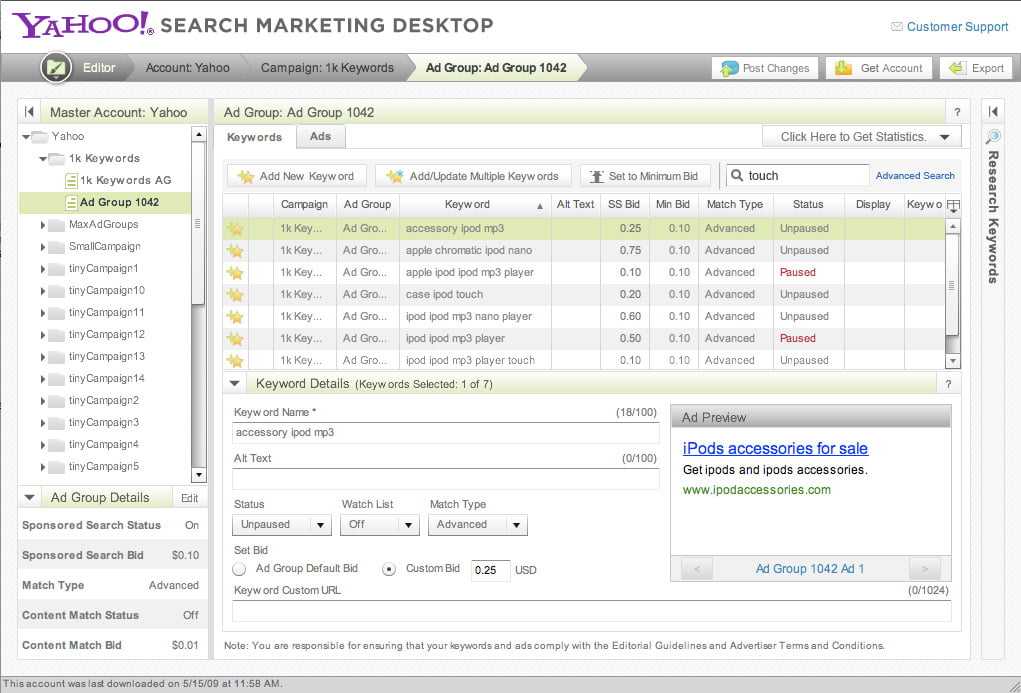Transforming Search Marketing
What is the role of a User Experience team when product teams are unwilling to revisit challenges customers have with their product? This was the challenge I faced when I arrived at Yahoo! and took over the UX team for Advertising. Specifically, Yahoo Search Marketing was very difficult to use. Members of the product team had been hearing from the UX team for a year before I arrived that the product had challenges, and they didn’t want to hear it any more. No matter how valid and reliable the data, the team found ways to ignore insights.
I suggested to the SVP of the organization that we were at a crisis that was going to impact us all, and recommended we bring the cross-functional team together to identify how we could increase profitable revenue. Specifically, I recommended facilitating a Rapid Design Lab. He agreed.
What is a rapid design lab? Rapid design labs are multi-day collaborative workshops where teams work together to solve major business problems. Teams review challenges, leverage intensive brainstorming and structured ideation exercises, engage in exercises to converge and validate ideas, and align around these ideas. In design labs, designers, engineers, product managers, and often users engage in brainstorming, convergence, collaborative design rapid prototyping, and user testing.
Because the existing product had so many challenges and the team would not prioritize changes, we found an alternate path to success: We defined a new product. Product Management agreed that we could create a much more focused, simpler desktop-based product to meet a use case that would help us monetize at a much higher rate. This ideation and definition process represented the first two days of the workshop.
Over the next two days, we sketched the new product, identified the core and differentiating capabilities, and then tested paper prototypes with users. On the last day of this five-day rapid design lab, each stakeholder agreed to a set of tasks that their organization would complete to drive the product forward.
It is important to note that leading up to this design lab, stakeholders from different groups seldom collaborated, and competed in unhealthy ways. During the rapid design lab, they came together and solved a big problem to produce a series of successes they had previously not experienced. Not only did each person in the design lab have emotional attachment to the new idea, but the design lab increased trust, candor, and collaboration among stakeholders. In the end, each individual took action to convince his or her executive staff. Each organization felt that the new idea arose organically from within their team, and thus they felt motivated to ensure its success. When we work together to solve real problems, organizations not only support the new concepts, but defend them on an emotional level.
Sketches of the new desktop tool during the rapid design lab
In the end, after deciding to build this product, we formed a very small team of approximately eight core members that worked in an Agile model and produced the new desktop search marketing product six months later. Note that as a comparison, the main product took over a hundred engineers three years to build. The result was that 95% of users—even novices—could successfully create a new search marketing campaign on the first attempt. From a revenue standpoint, we saw a 16% uplift in the first month this product was available.
Sketches of the new desktop tool during the rapid design lab
Rapid Design Labs – Accelerating Convergence
I have been conducting Rapid Design Labs to rapidly define transformative new product ideas and align cross-functional teams around these ideas for 15 years. Today, virtually every design agency offers its own unique flavor of innovation workshop. Such workshops are based on the concept of design-thinking, which is essentially a user-centered design process.
Rapid Design Labs enable teams to accomplish innovation and alignment that would typically take six months or more to achieve. At the end, they have a buildable product that customers will buy and users love.
In the end, Rapid Design Labs provide four basic value points. They enable:
- Rapid Innovation. Design labs are often also called Innovation Workshops.
- Cross-functional synthesis. Design labs solve pressing problems in a matter of days that can take many months—or even years—to solve otherwise. These workshops apply integrative thinking at the organizational level. In essence, experts in different disciplines (engineering, product management, and user experience) all perceive the world differently, including opportunities and constraints. Moreover, corporate culture rewards each discipline trying to push their opinion as the right one. Without all key stakeholders though, one cannot build products that differentiate, are marketable, and technically feasible. We need to leverage the best possible insights from each field. Design labs help synthesize different insights across disciplines.
- Deep accelerated dialogue. A big obstacle to innovation is the surface-level dialogue in most organizations, fragmented across meetings, email, and PowerPoint presentations. Design labs enable deeper dialogue. They bring teams together to solve problems in a shared space, which when facilitated properly by an experienced leader builds trust. Common goals ensure the teams must show productive output when they emerge from their multi-day event.
- Pivoting through lean design. In The Lean Startup, Eric Ries argues that the runway for any new product or company is defined by how many times it can successfully pivot itself—change direction—to deliver real customer value. Design labs are the perfect tool for lean design: They permit fast, cheap, objective pivots.
The job of a UX leader is to accelerate the dialog and convergence around experiences that both delight users and generate more profitable revenue. Rapid Design Labs are one of the tools that can help.


